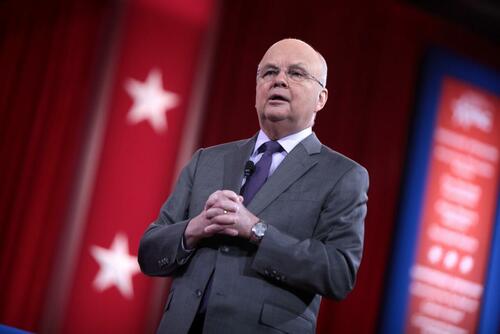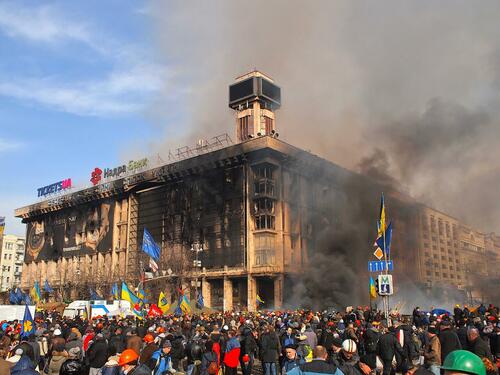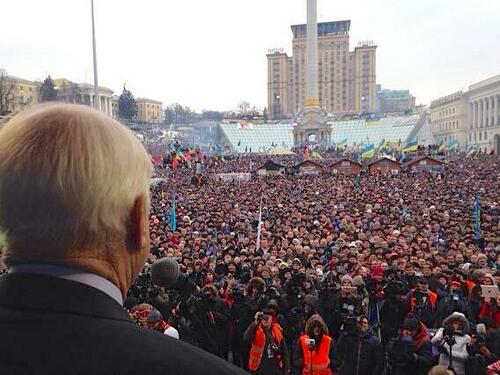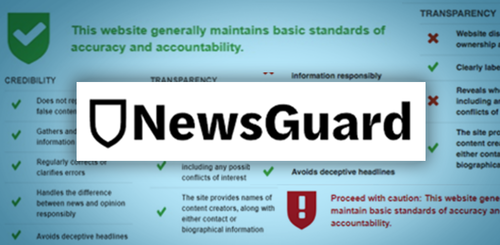
Authored by Joe Lauria via Consortium News,
Consortium News is being “reviewed” by NewsGuard, a U.S. government-linked organization that is trying to enforce a narrative on Ukraine while seeking to discredit dissenting views. The organization has accused Consortium News, begun in 1995 by former Associated Press investigative reporter Robert Parry, of publishing “false content” on Ukraine.
It calls “false” essential facts about Ukraine that have been suppressed in mainstream media: 1) that there was a U.S.-backed coup in 2014 and 2) that neo-Nazism is a significant force in Ukraine. Reporting crucial information left out of corporate media is Consortium News‘ essential mission. But NewsGuard considers these facts to be “myths” and is demanding Consortium News “correct” these “errors.”

Who is NewsGuard?
NewsGuard set itself up in 2018 as a judge of news organizations’ credibility. The front page of NewsGuard’s website shows that it is “partners” with the State Department and the Pentagon, as well as with several major corporations, such as Microsoft. The nature of these “partnerships” is not entirely clear.
NewsGuard is a private corporation that can shield itself from First Amendment obligations. But it has connections to formerly high-ranking U.S. government officials in addition to its “partnerships” with the State Dept. and the Pentagon.
Among those sitting on NewsGuard’s advisory board are Gen. Michael Hayden, the former Central Intelligence Agency and National Security Agency director; Tom Ridge, the first U.S. Homeland Security director and Anders Fogh Rasmussen, a former secretary general of NATO. NewGuard says its ”advisors provide advice and subject-matter expertise to NewsGuard. They play no role in the determinations of ratings or the Nutrition Label write ups of websites unless otherwise noted and have no role in the governance or management of the organization.”
The co-CEO, with former Wall Street Journal publisher Louis Gordon Crovitz, is Steven Brill, who in the 1990s published Brill’s Content, a magazine that was billed as a watchdog of the press, critiquing the role of the media to hold government to account. NewsGuard is a government-affiliated organization judging media like Consortium News that is totally independent of government or corporations.
NewsGuard has a rating process that results in a news organization receiving either a green or red label. Fox News and other major media, for example, have received green labels.
Getting a red label means that potentially millions of people that have the NewsGuard extension installed and operating on their browsers will see the green or red mark affixed to websites on social media and Google searches. (For individuals that do not already have it installed and operating on Microsoft’s browser, it costs $4.95 a month in the U.S., £4.95 in the U.K., or €4.95 in the EU to run the extension.)

According to NewsGuard, libraries in the U.S. and Britain have had it installed on their computers, and it is also being put on computers of U.S. active duty personnel. Slate reported in January 2019 that NewsGuard:
“struck a deal with Microsoft to incorporate those ratings into the tech giant’s Edge browser as an optional setting. That’s when the Guardian noticed that the Mail Online had been tagged by NewsGuard with a ‘red’ label, a reliability score of 3 out of 9, and the following warning: ‘Proceed with caution: This website generally fails to maintain basic standards of accuracy and accountability.’ For Microsoft Edge users with the ‘News Ratings’ feature turned on, that warning appeared alongside every link to the Mail Online—whether in Google search results, Facebook or Twitter feeds, or the Mail’s own homepage.”
Approach to Consortium News
Consortium News was contacted by NewsGuard analyst Zachary Fishman. In his request to speak to someone at Consortium News he said categorically that CN had published “false content” and that the interview would be on the record. “I’m hoping to talk with someone who could answer a few questions about its structure and editorial processes — including its ownership, its handling of corrections, and its publication of false content,” he wrote in an email.
As editor-in-chief, I informed him that our founder, editors and writers came from high levels of establishment journalism. I told him that in thousands of press interviews I’ve conducted over nearly half a century in journalism I had never known anyone accusing a prospective interviewee of misconduct upfront and then determining that the interview would be on the record, when the ground rules are usually set by the person being interviewed.
Fishman apologized and tried to say his mind wasn’t made up about Consortium News, when he had clearly stated that it was. “I do apologize that the wording of my email insinuated that I had come to a predetermined conclusion on whether your website has published false content, when I have not — be sure that I am interested in your responses to my questions,” he wrote in an email.
According to his LinkedIn profile, Fishman had one previous job in science and financial journalism that lasted 15 months for a company called Fastinform that is now defunct. Last month, all the links of his published pieces on LinkedIn went to a site that no longer exists. The links have now been removed.
Fishman has degrees in health, environment and science journalism and engineering physics. He has no experience in political reporting and especially of the politics of Eastern Europe and U.S.-Russia relations.
NewsGuard’s determination on Consortium News will be made by the analyst and, “At least one senior editor and NewsGuard’s co-CEOs review every Nutrition Label prior to publication to ensure that the rating is as fair and accurate as possible.”
Charge: There Was ‘No US-Backed Coup’
NewsGuard alleges that Consortium News has published “false content” by reporting that there was a U.S.-backed coup in Ukraine in 2014 and that neo-Nazis have significant influence in the country.
Fishman took issue with a:
“February 2022 article ‘Ukraine: Guides to Reflection,’ [which] asserted, ‘Hence, the inflation of Russian behavior in Ukraine (where Washington organized a coup against a democratically elected government because we disliked its political complexion) … .’
Fishman then wrote:
“The U.S. supported the Maidan revolution that ousted then-Ukraine President Viktor Yanikovych (sic) in 2014 — including a December 2013 visit by John McCain to Kyiv in support of protesters — but there is no evidence that the U.S. ‘organized’ a ‘coup.’ Instead, it has the markings of a popular uprising, precipitated by widely covered protests against Yanukovych’s decision to suspend preparations for the signing of an association and free-trade agreement with the European Union.”
Viktor Yanukovych was democratically elected as president of Ukraine in 2010 in an election certified by the Organization for Security and Cooperation in Europe, a fact not mentioned in NewsGuard’s writings on the change of government in Ukraine. Even though Yanukovych agreed to an EU political settlement and early elections, violence forced him to flee from the capital on Feb. 21, 2014. Reporting that the neo-Nazi Right Sector was at the forefront of the violent overthrow, The New York Times (green check) wrote earlier that day:
“Dmytro Yarosh, the leader of Right Sector, a coalition of hard-line nationalist groups, reacted defiantly to news of the settlement, drawing more cheers from the crowd.
‘The agreements that were reached do not correspond to our aspirations,’ he said. ‘Right Sector will not lay down arms. Right Sector will not lift the blockade of a single administrative building until our main demand is met — the resignation of Yanukovych.’ He added that he and his supporters were ‘ready to take responsibility for the further development of the revolution.’ The crowd shouted: ‘Good! Good!’
A study on the violence used to overthrow the government, by Prof. Serhiy Kudelia, a political scientist at Baylor University, says the overthrow succeeded because of “the embeddedness of violent groups” in a non-violent protest. The violence began on Dec. 1, 2013 when these violent groups attacked police with “iron chains, flares, stones and petrol bombs” and tried to ram a bulldozer through police lines. The police viciously fought back that day.
As the International Business Times (IBT) (green check) wrote about these groups at the time:
“According to a member of anti-fascist Union Ukraine, a group that monitors and fights fascism in Ukraine, ‘There are lots of nationalists here [EuroMaidan] including Nazis. They came from all over Ukraine, and they make up about 30% of protesters.
Different groups [of anarchists] came together for a meeting on the Maidan. While they were meeting, a group of Nazis came in a larger group, they had axes and baseball bats and sticks, helmets, they said it was their territory. They called the anarchists things like Jews, blacks, communists. There weren’t even any communists, that was just an insult. The anarchists weren’t expecting this and they left. People with other political views can’t stay in certain places, they aren’t tolerated,’ a member of the group continued.”
The violence by far-right groups was evidently condoned by Sen. John McCain who expressed his support for the uprising by addressing the Maidan crowd later that month. Assistant Secretary of State Victoria Nuland and then U.S. ambassador Geoffrey Pyatt visited the square after the violence had broken out.

NewsGuard’s account of the events of Feb. 21, 2014 says that even though Yanukovych agreed to the early elections, “angry protestors demanded Yanukovych’s immediate resignation,” and he fled on that day after “hundreds of police guarding government buildings abandoned their posts.” NewsGuard then says “protestors took control of several government buildings the next day.”
Government Buildings Seized
But protestors had already seized government buildings as early as December 2013. On Jan. 24 protestors broke into the Agriculture Ministry building in Kiev and occupied it. On the same day barricades were set up near the presidential headquarters. Government buildings in the west of the country had also been occupied. The Guardian (green check) reported on Jan. 24:
“There were dramatic developments in the west of the country on Thursday as hundreds of people forced their way into the office of the regional governor in the city of Lviv, and forced him to sign a resignation letter. Oleh Salo, a Yanukovych appointee in a city where support for the president is in the low single digits, later said he signed the letter under duress and was rescinding his resignation.
Thousands also stormed regional administration headquarters in Rivne on Thursday, breaking down doors and demanding the release of people detained in the unrest there, Unian news agency reported. In the town of Cherkasy, 125 miles south of Kiev, about 1,000 protesters took over the first two floors of the main administration building and lit fires outside the building.
Similar action took place in Ternopil, Ivano-Frankivsk and Khmelnytsky in western and central Ukraine, as well as parts of the north-east, the Party of the Regions said.”
Protestors had begun occupying Kiev City Hall in December, with a portrait of Ukraine’s World War II fascist leader Stepan Bandera hanging from the rafters. On the night of Feb. 21, the leader of the Neo-fascist Right Sector, Andriy Parubiy, announced that the Verkhovna Rada (parliament), the Presidential Administration, the Cabinet of Ministers and the Ministry of Internal Affairs had all come under control of the protestors.
Therefore NewsGuard has published “false content” by reporting that government buildings were occupied the day after Yanukovych fled the capital. It should print a correction.
On the day after Yanukovych fled, the Rada voted without the presence of Yanukovych’s party — the largest in the country — to impeach him after the fact of his violent overthrow. NewsGuard omitted the key fact that the impeachment vote was tainted by the absence of Yanukovych’s party and that the impeachment became largely irrelevant after violence forced him to flee the capital.
Democratically-elected leaders are removed by electoral defeat, impeachment or votes of no confidence, not by violence. NewsGuard writes that “hundreds of police guarding government buildings abandoned their posts” on the day Yanukovych was forced out, but doesn’t say why. As Jacobin (NewsGuard green check) magazine reports:
“Whatever one thinks of the Maidan protests, the increasing violence of those involved was key to their ultimate victory. In response to a brutal police crackdown, protesters began fighting with chains, sticks, stones, petrol bombs, even a bulldozer — and, eventually, firearms, all culminating in what was effectively an armed battle in February, which left thirteen police officers and nearly fifty protesters dead. The police ‘could no longer defend themselves’ from protesters’ attacks,’ writes political scientist Sergiy Kudelia, causing them to retreat, and precipitating Yanukovych’s exit.”
NewsGuard calls the events a “revolution,” yet revolutions in history have typically been against monarchs or dictators, not against democratically-elected leaders. For instance, the 1776 American Revolution, the 1789 French Revolution, the 1917 Russian Revolution, the 1952 Egyptian Revolution, the 1979 Iranian Revolution and countless others were against monarchs. Coups have been against both elected and non-elected leaders. Revolutions change political systems, usually from monarchies to republics. Ukraine’s political system was not changed, only its leader.
By any measure, Yanukovych’s ouster was an unconstitutional change in government. His “impeachment” without his party present for the vote came after government buildings had been seized and after violence drove him from the capital.
Circumstantial Evidence
In its version of these events, NewsGuard only refers to circumstantial evidence of the coup, interpreting it as U.S. “support” for a “revolution” against a democratically-elected president.
NewsGuard fails to point out that McCain, Sen. Christopher Murphy (D-CT) as well as Nuland appeared on stage in the Maidan with Oleh Tyahnybok, leader of the Neo-fascist Svoboda Party, formerly known as the Social National Party.
NewsGuard does not consider how such events would be seen in the United States if a senior Russian foreign ministry official, two leading Russian lawmakers and Russia’s ambassador to the U.S. appeared on stage with a far-right American leader to address a crowd on the Washington Mall seeking to oust an elected U.S. president. If that president were overthrown violently, would Americans think it Russian-backed the coup?

NewsGuard discusses Nuland’s 2013 speech in which she revealed that since 1991 the U.S. had spent $5 billion to help bring about Ukraine’s “aspirations.” What it fails to point out is that U.S. aspirations were to turn Ukraine towards the West and away from Russia. And the U.S. had work to do.
In a 2008 poll, 17 years after this U.S. effort began, and the year in which the U.S. said Ukraine would one day join NATO, 50 percent of Ukrainians actually opposed NATO membership against just 24.3 percent who favored it. A 2010 Gallup poll showed that 40 percent of Ukrainians viewed NATO as more threat than protector. Just 17 percent had the opposite view. So building up civil society through U.S.-funded NGOs to favor the West was the U.S. challenge.
NewsGuard does not mention that part of the $5 billion the U.S. spent was to help organize protests. There was genuine popular dissatisfaction with Yanukovych that the NED nurtured and trained. Jacobin reported of the 2014 events:
“US officials, unhappy with the scuttled EU deal, saw a similar chance in the Maidan protests. Just two months before they broke out, the NED’s then president, pointing to Yanukovych’s European outreach, wrote that “the opportunities are considerable, and there are important ways Washington could help.”
In practice, this meant funding groups like New Citizen, which the Financial Times reported “played a big role in getting the protest up and running,” led by a pro-EU opposition figure. Journalist Mark Ames discovered the organization had received hundreds of thousands of dollars from US democracy promotion initiatives.”
Writing in Consortium News six days after Yanukovych’s ouster, Parry reported that over the previous year, the National Endowment for Democracy (NED), which funds NGOs in countries the U.S. targets for regime change, had bankrolled 65 projects in Ukraine totaling more than $20 million. Parry called it “a shadow political structure of media and activist groups that could be deployed to stir up unrest when the Ukrainian government didn’t act as desired.”
The NED, on Feb. 25, the day after the Russian invasion, deleted all projects in Ukraine it funded, which are archived here. The NED meddled in Ukrainian politics in 2004 in the so-called Orange Revolution. The Washington Post (green check) wrote in 1991 that what the C.I.A. once did in secret — destabilizing and overthrowing regimes — the NED was now doing openly.
C.I.A. or NED-led coups are never made up out of whole cloth. The U.S. works with genuine opposition movements within a country, sometimes popular uprisings, to finance, train and direct them. This U.S. has a long history of overthrowing foreign governments, the most infamous examples being Iran in 1953, Guatemala in 1954, and Chile in 1973.
In September 2013, before the Maidan uprising began, long-time NED head Carl Gerhsman called Ukraine “the biggest prize” in a Washington Post op-ed piece, and warned that “Russians, too, face a choice, and Putin may find himself on the losing end not just in the near abroad but within Russia itself.”
In 2016 he said the NED has been involved in Ukraine since the 1980s and he praised the “overthrow of Yanukovych.”
Nuland-Pyatt Tape Omitted
Most significantly, NewsGuard’s attempt to refute U.S. involvement in the coup omits the 2014 intercepted and leaked telephone call between Nuland and Pyatt, the then U.S. ambassador to Ukraine, in which the two discuss who will make up the new government weeks before Yanukovych was overthrown.
On the leaked tape, Nuland and Pyatt talk about “midwifing” a new government; Vice President Joe Biden’s role, and setting up meetings with Ukrainian politicians to make it happen. Nuland says the prime minister should be Arseniy Yatsenyuk, and indeed he became prime minister after the coup.
At the time, the BBC (green check) wrote of the leak: “The US says that it is working with all sides in the crisis to reach a peaceful solution, noting that ‘ultimately it is up to the Ukrainian people to decide their future’. However this transcript suggests that the US has very clear ideas about what the outcome should be and is striving to achieve these goals.”
The U.S. State Department never denied the authenticity of the video, and even issued an apology to the European Union after Nuland is heard on the tape saying, “Fuck the EU.” Mainstream media at the time focused almost exclusively on that off-color remark as a distraction from the greater significance of U.S. interference in Ukraine’s internal affairs.
Why did Nuland say, “Fuck the EU”? At the time she said it, France, Germany and Poland were working for the EU on a political settlement with Russia to the Maidan crisis that would leave Yanukovych in power.
Indeed the E.U. brokered a deal with Yanukovych, who agreed to early elections by December, a restoration of the 2004 Constitution and an amnesty for all protestors, clearing the way for no one to be held responsible for the violent ouster. Yanukovych announced the agreement, with E.U. officials at his side in Kiev, on Feb. 21, 2014. Later that day he was violently driven from power.
Leaving the historic role of the NED and the essential Nuland-Pyatt conversation out of its reporting is an omission of evidence by NewsGuard, typical of corporate media. Omitting crucial elements of a story changes its meaning and in this case undermines NewsGuard’s account of the events of 2014.
This is an excellent example of why Parry started Consortium News: to report on crucial information that corporate media sometimes purposely and deceptively leave out to change the meaning of a story. NewsGuard should correct its story about the coup, not Consortium News.
The rest of the full report at Consortium News...
Authored by Joe Lauria via Consortium News,
Consortium News is being “reviewed” by NewsGuard, a U.S. government-linked organization that is trying to enforce a narrative on Ukraine while seeking to discredit dissenting views. The organization has accused Consortium News, begun in 1995 by former Associated Press investigative reporter Robert Parry, of publishing “false content” on Ukraine.
It calls “false” essential facts about Ukraine that have been suppressed in mainstream media: 1) that there was a U.S.-backed coup in 2014 and 2) that neo-Nazism is a significant force in Ukraine. Reporting crucial information left out of corporate media is Consortium News‘ essential mission. But NewsGuard considers these facts to be “myths” and is demanding Consortium News “correct” these “errors.”

Who is NewsGuard?
NewsGuard set itself up in 2018 as a judge of news organizations’ credibility. The front page of NewsGuard’s website shows that it is “partners” with the State Department and the Pentagon, as well as with several major corporations, such as Microsoft. The nature of these “partnerships” is not entirely clear.
NewsGuard is a private corporation that can shield itself from First Amendment obligations. But it has connections to formerly high-ranking U.S. government officials in addition to its “partnerships” with the State Dept. and the Pentagon.
Among those sitting on NewsGuard’s advisory board are Gen. Michael Hayden, the former Central Intelligence Agency and National Security Agency director; Tom Ridge, the first U.S. Homeland Security director and Anders Fogh Rasmussen, a former secretary general of NATO. NewGuard says its ”advisors provide advice and subject-matter expertise to NewsGuard. They play no role in the determinations of ratings or the Nutrition Label write ups of websites unless otherwise noted and have no role in the governance or management of the organization.”
The co-CEO, with former Wall Street Journal publisher Louis Gordon Crovitz, is Steven Brill, who in the 1990s published Brill’s Content, a magazine that was billed as a watchdog of the press, critiquing the role of the media to hold government to account. NewsGuard is a government-affiliated organization judging media like Consortium News that is totally independent of government or corporations.
NewsGuard has a rating process that results in a news organization receiving either a green or red label. Fox News and other major media, for example, have received green labels.
Getting a red label means that potentially millions of people that have the NewsGuard extension installed and operating on their browsers will see the green or red mark affixed to websites on social media and Google searches. (For individuals that do not already have it installed and operating on Microsoft’s browser, it costs $4.95 a month in the U.S., £4.95 in the U.K., or €4.95 in the EU to run the extension.)

According to NewsGuard, libraries in the U.S. and Britain have had it installed on their computers, and it is also being put on computers of U.S. active duty personnel. Slate reported in January 2019 that NewsGuard:
“struck a deal with Microsoft to incorporate those ratings into the tech giant’s Edge browser as an optional setting. That’s when the Guardian noticed that the Mail Online had been tagged by NewsGuard with a ‘red’ label, a reliability score of 3 out of 9, and the following warning: ‘Proceed with caution: This website generally fails to maintain basic standards of accuracy and accountability.’ For Microsoft Edge users with the ‘News Ratings’ feature turned on, that warning appeared alongside every link to the Mail Online—whether in Google search results, Facebook or Twitter feeds, or the Mail’s own homepage.”
Approach to Consortium News
Consortium News was contacted by NewsGuard analyst Zachary Fishman. In his request to speak to someone at Consortium News he said categorically that CN had published “false content” and that the interview would be on the record. “I’m hoping to talk with someone who could answer a few questions about its structure and editorial processes — including its ownership, its handling of corrections, and its publication of false content,” he wrote in an email.
As editor-in-chief, I informed him that our founder, editors and writers came from high levels of establishment journalism. I told him that in thousands of press interviews I’ve conducted over nearly half a century in journalism I had never known anyone accusing a prospective interviewee of misconduct upfront and then determining that the interview would be on the record, when the ground rules are usually set by the person being interviewed.
Fishman apologized and tried to say his mind wasn’t made up about Consortium News, when he had clearly stated that it was. “I do apologize that the wording of my email insinuated that I had come to a predetermined conclusion on whether your website has published false content, when I have not — be sure that I am interested in your responses to my questions,” he wrote in an email.
According to his LinkedIn profile, Fishman had one previous job in science and financial journalism that lasted 15 months for a company called Fastinform that is now defunct. Last month, all the links of his published pieces on LinkedIn went to a site that no longer exists. The links have now been removed.
Fishman has degrees in health, environment and science journalism and engineering physics. He has no experience in political reporting and especially of the politics of Eastern Europe and U.S.-Russia relations.
NewsGuard’s determination on Consortium News will be made by the analyst and, “At least one senior editor and NewsGuard’s co-CEOs review every Nutrition Label prior to publication to ensure that the rating is as fair and accurate as possible.”
Charge: There Was ‘No US-Backed Coup’
NewsGuard alleges that Consortium News has published “false content” by reporting that there was a U.S.-backed coup in Ukraine in 2014 and that neo-Nazis have significant influence in the country.
Fishman took issue with a:
“February 2022 article ‘Ukraine: Guides to Reflection,’ [which] asserted, ‘Hence, the inflation of Russian behavior in Ukraine (where Washington organized a coup against a democratically elected government because we disliked its political complexion) … .’
Fishman then wrote:
“The U.S. supported the Maidan revolution that ousted then-Ukraine President Viktor Yanikovych (sic) in 2014 — including a December 2013 visit by John McCain to Kyiv in support of protesters — but there is no evidence that the U.S. ‘organized’ a ‘coup.’ Instead, it has the markings of a popular uprising, precipitated by widely covered protests against Yanukovych’s decision to suspend preparations for the signing of an association and free-trade agreement with the European Union.”
Viktor Yanukovych was democratically elected as president of Ukraine in 2010 in an election certified by the Organization for Security and Cooperation in Europe, a fact not mentioned in NewsGuard’s writings on the change of government in Ukraine. Even though Yanukovych agreed to an EU political settlement and early elections, violence forced him to flee from the capital on Feb. 21, 2014. Reporting that the neo-Nazi Right Sector was at the forefront of the violent overthrow, The New York Times (green check) wrote earlier that day:
“Dmytro Yarosh, the leader of Right Sector, a coalition of hard-line nationalist groups, reacted defiantly to news of the settlement, drawing more cheers from the crowd.
‘The agreements that were reached do not correspond to our aspirations,’ he said. ‘Right Sector will not lay down arms. Right Sector will not lift the blockade of a single administrative building until our main demand is met — the resignation of Yanukovych.’ He added that he and his supporters were ‘ready to take responsibility for the further development of the revolution.’ The crowd shouted: ‘Good! Good!’
A study on the violence used to overthrow the government, by Prof. Serhiy Kudelia, a political scientist at Baylor University, says the overthrow succeeded because of “the embeddedness of violent groups” in a non-violent protest. The violence began on Dec. 1, 2013 when these violent groups attacked police with “iron chains, flares, stones and petrol bombs” and tried to ram a bulldozer through police lines. The police viciously fought back that day.
As the International Business Times (IBT) (green check) wrote about these groups at the time:
“According to a member of anti-fascist Union Ukraine, a group that monitors and fights fascism in Ukraine, ‘There are lots of nationalists here [EuroMaidan] including Nazis. They came from all over Ukraine, and they make up about 30% of protesters.
Different groups [of anarchists] came together for a meeting on the Maidan. While they were meeting, a group of Nazis came in a larger group, they had axes and baseball bats and sticks, helmets, they said it was their territory. They called the anarchists things like Jews, blacks, communists. There weren’t even any communists, that was just an insult. The anarchists weren’t expecting this and they left. People with other political views can’t stay in certain places, they aren’t tolerated,’ a member of the group continued.”
The violence by far-right groups was evidently condoned by Sen. John McCain who expressed his support for the uprising by addressing the Maidan crowd later that month. Assistant Secretary of State Victoria Nuland and then U.S. ambassador Geoffrey Pyatt visited the square after the violence had broken out.

NewsGuard’s account of the events of Feb. 21, 2014 says that even though Yanukovych agreed to the early elections, “angry protestors demanded Yanukovych’s immediate resignation,” and he fled on that day after “hundreds of police guarding government buildings abandoned their posts.” NewsGuard then says “protestors took control of several government buildings the next day.”
Government Buildings Seized
But protestors had already seized government buildings as early as December 2013. On Jan. 24 protestors broke into the Agriculture Ministry building in Kiev and occupied it. On the same day barricades were set up near the presidential headquarters. Government buildings in the west of the country had also been occupied. The Guardian (green check) reported on Jan. 24:
“There were dramatic developments in the west of the country on Thursday as hundreds of people forced their way into the office of the regional governor in the city of Lviv, and forced him to sign a resignation letter. Oleh Salo, a Yanukovych appointee in a city where support for the president is in the low single digits, later said he signed the letter under duress and was rescinding his resignation.
Thousands also stormed regional administration headquarters in Rivne on Thursday, breaking down doors and demanding the release of people detained in the unrest there, Unian news agency reported. In the town of Cherkasy, 125 miles south of Kiev, about 1,000 protesters took over the first two floors of the main administration building and lit fires outside the building.
Similar action took place in Ternopil, Ivano-Frankivsk and Khmelnytsky in western and central Ukraine, as well as parts of the north-east, the Party of the Regions said.”
Protestors had begun occupying Kiev City Hall in December, with a portrait of Ukraine’s World War II fascist leader Stepan Bandera hanging from the rafters. On the night of Feb. 21, the leader of the Neo-fascist Right Sector, Andriy Parubiy, announced that the Verkhovna Rada (parliament), the Presidential Administration, the Cabinet of Ministers and the Ministry of Internal Affairs had all come under control of the protestors.
Therefore NewsGuard has published “false content” by reporting that government buildings were occupied the day after Yanukovych fled the capital. It should print a correction.
On the day after Yanukovych fled, the Rada voted without the presence of Yanukovych’s party — the largest in the country — to impeach him after the fact of his violent overthrow. NewsGuard omitted the key fact that the impeachment vote was tainted by the absence of Yanukovych’s party and that the impeachment became largely irrelevant after violence forced him to flee the capital.
Democratically-elected leaders are removed by electoral defeat, impeachment or votes of no confidence, not by violence. NewsGuard writes that “hundreds of police guarding government buildings abandoned their posts” on the day Yanukovych was forced out, but doesn’t say why. As Jacobin (NewsGuard green check) magazine reports:
“Whatever one thinks of the Maidan protests, the increasing violence of those involved was key to their ultimate victory. In response to a brutal police crackdown, protesters began fighting with chains, sticks, stones, petrol bombs, even a bulldozer — and, eventually, firearms, all culminating in what was effectively an armed battle in February, which left thirteen police officers and nearly fifty protesters dead. The police ‘could no longer defend themselves’ from protesters’ attacks,’ writes political scientist Sergiy Kudelia, causing them to retreat, and precipitating Yanukovych’s exit.”
NewsGuard calls the events a “revolution,” yet revolutions in history have typically been against monarchs or dictators, not against democratically-elected leaders. For instance, the 1776 American Revolution, the 1789 French Revolution, the 1917 Russian Revolution, the 1952 Egyptian Revolution, the 1979 Iranian Revolution and countless others were against monarchs. Coups have been against both elected and non-elected leaders. Revolutions change political systems, usually from monarchies to republics. Ukraine’s political system was not changed, only its leader.
By any measure, Yanukovych’s ouster was an unconstitutional change in government. His “impeachment” without his party present for the vote came after government buildings had been seized and after violence drove him from the capital.
Circumstantial Evidence
In its version of these events, NewsGuard only refers to circumstantial evidence of the coup, interpreting it as U.S. “support” for a “revolution” against a democratically-elected president.
NewsGuard fails to point out that McCain, Sen. Christopher Murphy (D-CT) as well as Nuland appeared on stage in the Maidan with Oleh Tyahnybok, leader of the Neo-fascist Svoboda Party, formerly known as the Social National Party.
NewsGuard does not consider how such events would be seen in the United States if a senior Russian foreign ministry official, two leading Russian lawmakers and Russia’s ambassador to the U.S. appeared on stage with a far-right American leader to address a crowd on the Washington Mall seeking to oust an elected U.S. president. If that president were overthrown violently, would Americans think it Russian-backed the coup?

NewsGuard discusses Nuland’s 2013 speech in which she revealed that since 1991 the U.S. had spent $5 billion to help bring about Ukraine’s “aspirations.” What it fails to point out is that U.S. aspirations were to turn Ukraine towards the West and away from Russia. And the U.S. had work to do.
In a 2008 poll, 17 years after this U.S. effort began, and the year in which the U.S. said Ukraine would one day join NATO, 50 percent of Ukrainians actually opposed NATO membership against just 24.3 percent who favored it. A 2010 Gallup poll showed that 40 percent of Ukrainians viewed NATO as more threat than protector. Just 17 percent had the opposite view. So building up civil society through U.S.-funded NGOs to favor the West was the U.S. challenge.
NewsGuard does not mention that part of the $5 billion the U.S. spent was to help organize protests. There was genuine popular dissatisfaction with Yanukovych that the NED nurtured and trained. Jacobin reported of the 2014 events:
“US officials, unhappy with the scuttled EU deal, saw a similar chance in the Maidan protests. Just two months before they broke out, the NED’s then president, pointing to Yanukovych’s European outreach, wrote that “the opportunities are considerable, and there are important ways Washington could help.”
In practice, this meant funding groups like New Citizen, which the Financial Times reported “played a big role in getting the protest up and running,” led by a pro-EU opposition figure. Journalist Mark Ames discovered the organization had received hundreds of thousands of dollars from US democracy promotion initiatives.”
Writing in Consortium News six days after Yanukovych’s ouster, Parry reported that over the previous year, the National Endowment for Democracy (NED), which funds NGOs in countries the U.S. targets for regime change, had bankrolled 65 projects in Ukraine totaling more than $20 million. Parry called it “a shadow political structure of media and activist groups that could be deployed to stir up unrest when the Ukrainian government didn’t act as desired.”
The NED, on Feb. 25, the day after the Russian invasion, deleted all projects in Ukraine it funded, which are archived here. The NED meddled in Ukrainian politics in 2004 in the so-called Orange Revolution. The Washington Post (green check) wrote in 1991 that what the C.I.A. once did in secret — destabilizing and overthrowing regimes — the NED was now doing openly.
C.I.A. or NED-led coups are never made up out of whole cloth. The U.S. works with genuine opposition movements within a country, sometimes popular uprisings, to finance, train and direct them. This U.S. has a long history of overthrowing foreign governments, the most infamous examples being Iran in 1953, Guatemala in 1954, and Chile in 1973.
In September 2013, before the Maidan uprising began, long-time NED head Carl Gerhsman called Ukraine “the biggest prize” in a Washington Post op-ed piece, and warned that “Russians, too, face a choice, and Putin may find himself on the losing end not just in the near abroad but within Russia itself.”
In 2016 he said the NED has been involved in Ukraine since the 1980s and he praised the “overthrow of Yanukovych.”
Nuland-Pyatt Tape Omitted
Most significantly, NewsGuard’s attempt to refute U.S. involvement in the coup omits the 2014 intercepted and leaked telephone call between Nuland and Pyatt, the then U.S. ambassador to Ukraine, in which the two discuss who will make up the new government weeks before Yanukovych was overthrown.
On the leaked tape, Nuland and Pyatt talk about “midwifing” a new government; Vice President Joe Biden’s role, and setting up meetings with Ukrainian politicians to make it happen. Nuland says the prime minister should be Arseniy Yatsenyuk, and indeed he became prime minister after the coup.
[embedded content]
At the time, the BBC (green check) wrote of the leak: “The US says that it is working with all sides in the crisis to reach a peaceful solution, noting that ‘ultimately it is up to the Ukrainian people to decide their future’. However this transcript suggests that the US has very clear ideas about what the outcome should be and is striving to achieve these goals.”
The U.S. State Department never denied the authenticity of the video, and even issued an apology to the European Union after Nuland is heard on the tape saying, “Fuck the EU.” Mainstream media at the time focused almost exclusively on that off-color remark as a distraction from the greater significance of U.S. interference in Ukraine’s internal affairs.
Why did Nuland say, “Fuck the EU”? At the time she said it, France, Germany and Poland were working for the EU on a political settlement with Russia to the Maidan crisis that would leave Yanukovych in power.
Indeed the E.U. brokered a deal with Yanukovych, who agreed to early elections by December, a restoration of the 2004 Constitution and an amnesty for all protestors, clearing the way for no one to be held responsible for the violent ouster. Yanukovych announced the agreement, with E.U. officials at his side in Kiev, on Feb. 21, 2014. Later that day he was violently driven from power.
Leaving the historic role of the NED and the essential Nuland-Pyatt conversation out of its reporting is an omission of evidence by NewsGuard, typical of corporate media. Omitting crucial elements of a story changes its meaning and in this case undermines NewsGuard’s account of the events of 2014.
This is an excellent example of why Parry started Consortium News: to report on crucial information that corporate media sometimes purposely and deceptively leave out to change the meaning of a story. NewsGuard should correct its story about the coup, not Consortium News.
The rest of the full report at Consortium News…






